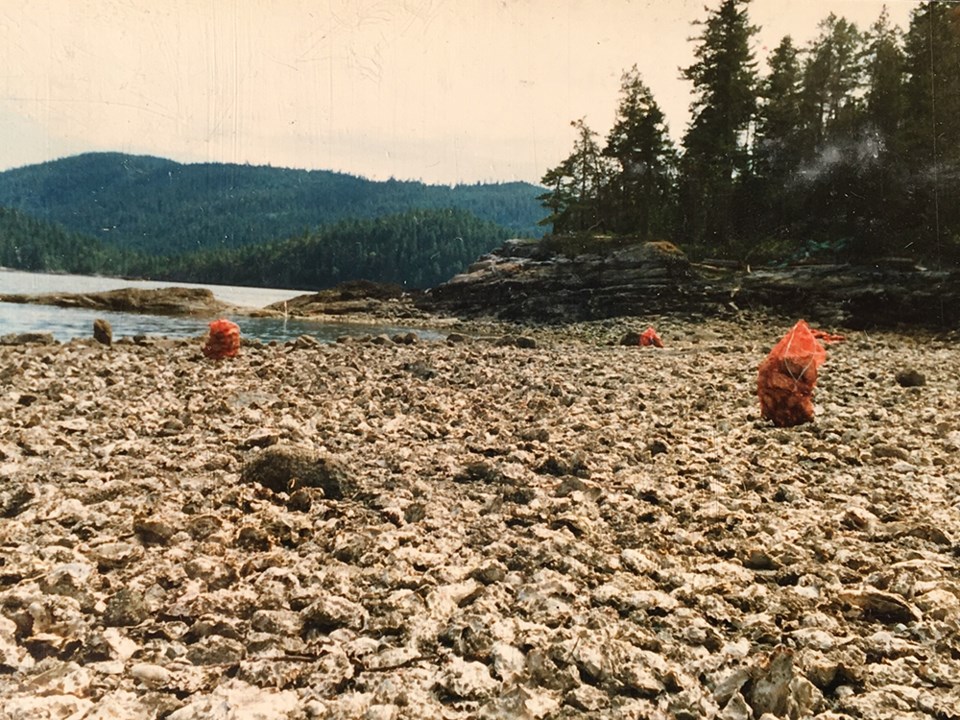Chapter nine recap: Linda and Wayne shot down a large cougar in their yard that measured nine feet from nose to tail, but they became terribly ill when they ate it. The cougars continued to come around until they had decimated Linda’s goat herd. Linda decided it was time to shift the focus to their farm below the tide line: oysters.
“That’s the hardest part, to actually get out of the nice, warm bed and get out the door,” recounted Linda Syms. “Once you get out there it’s not that bad, actually.”
That was Linda describing her life as an oyster farmer, a profession she and Wayne quickly realized was a mostly nocturnal career conducted in the winter.
Desolation Sound famously boasts the warmest ocean water north of the Gulf of Mexico in the summer. It’s that warm water that creates the perfect conditions for the mass spawning of the oysters, but unfortunately, if you’re an oyster farmer, those glorious summer days, when low tide occurs around noon, are the wrong time of year to pick; spawning oysters are often soft, gooey and translucent. They don’t taste or look great.
Linda learned that oysters are at their best for picking when the ocean water is cold. Frigid. That’s when the meat becomes firm and white, and in the winter in Desolation Sound, the low winter tides perfect for the picks just so happen to be in the middle of the night.
That meant Linda and Wayne had to radically alter their sleep schedule in order to embrace their chilly oceanic graveyard shift. In the winter months, depending on the tide charts, they forced themselves to go to bed with the setting sun, hitting the pillow no later than 5 pm.
At the beginning of the week, they’d be back up by 10 pm, but low tides shift later by about an hour each night, which meant they had to get up later and later, or earlier and earlier, depending on how you figured it, as the week progressed.
By the end of the week, the constantly changing hours created complete sleep confusion. Imagine this: December rain pelts against the window while you’re snug, warm and dry under the covers near your glowing wood stove. Would you get up?
It was in those moments when Linda often asked herself: “What will win tonight, the pillow or the paycheque?”
Many more times than not, she got up. Dressed head to toe in fleece and rain gear, she and Wayne battled that stinging rain, along with wind, snow, hail, fog or ice, to collect their oysters. Rubber gloves, picking tools, spotlights, headlamps, propane lamps and back-up lights all helped. After getting caught out on the beach in the middle of the night with no working light a few times, Linda became paranoid and kept a flashlight in every pocket.
Dark drive
Together with their big dog, Laz, they’d climb into their cold, wet, aluminum herring skiff and begin the dark drive to one of the five picking beaches along their kilometre-long shellfish lease. They’d quickly unload all of their gear, then shove the boat out so it didn’t get hung up on the outgoing tide, making sure to run a line to shore.
As Linda mentioned, sometimes, even in the middle of winter, it wasn’t so bad. Linda began to notice that once the tide began to drop, more often than not, the rain would stop, the wind would die down and everything would become very calm and still. Nights lit up by a full moon were particularly beautiful, the beaches becoming illuminated in shades of silver and grey.
As soon as they bent over and started picking, talking between Linda and Wayne was forbidden. It was too easy to lose count. 60 oysters per bag, over and over and over again.
They enveloped themselves in the winter silence of Desolation Sound, the only sound being the soft clicking of barnacle shells, the squirt of clams disturbed by rubber boots, or the far off rush of a waterfall somewhere on the other side of the inlet.
Crouched on kneepads over a bed of razor sharp oyster shells, they’d be hunched almost in the fetal position, searching for the best sizes. They began to enforce mandatory standing and stretching breaks, since chronic back pain, aching knees and bleeding fingers are the trademark of the oyster trade. Eventually, the physical toll of those picks would catch up to Wayne.
Linda and Wayne would aim to work about six hours a night, with the goal of collecting about 400 or 500 dozen, or 6,000 oysters a week.
Occasionally, they would see another flicker of light on the opposite shoreline, one of the other 15 or so oyster farmers in the Okeover Inlet and Desolation Sound area. Or so they hoped.
If the weather and darkness didn’t provide enough of a challenge, there was one other problem that continued to plague their farming livelihood: poaching. Every once in a while, Linda and Wayne would catch the oyster offenders red-handed.
You’ll read that story in the next chapter of Wild Pick: The life and adventures of Linda Syms, oyster farmer of Desolation Sound.
Grant Lawrence is the author of the new #1 bestselling book Return to Solitude who considers Powell River and Desolation Sound his second home. Grant’s book and Linda’s two books: Salt Water Rain and Shell Games are for sale at Pollen Sweaters in Lund, and Pocket Books and Marine Traders in Powell River.



